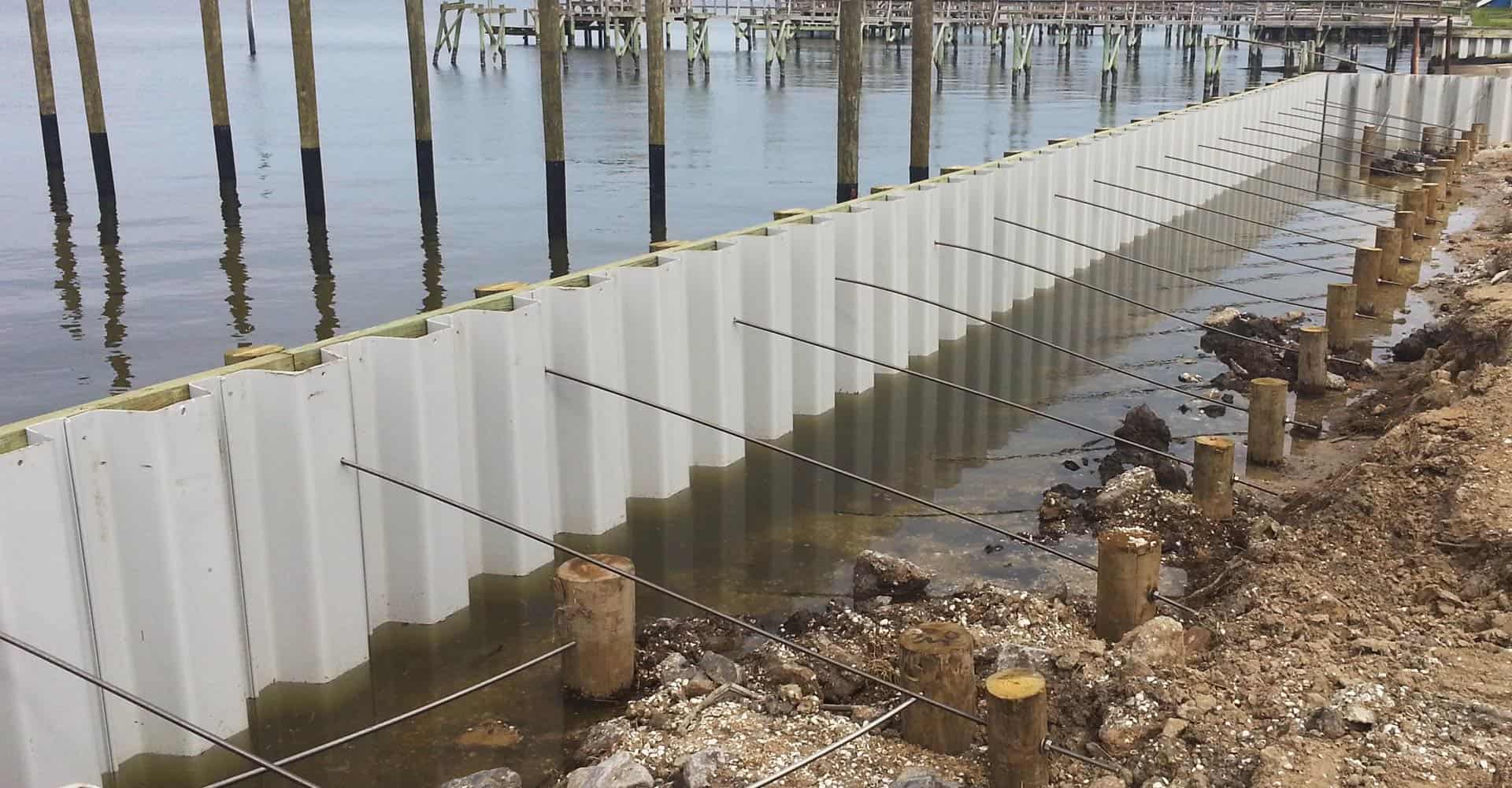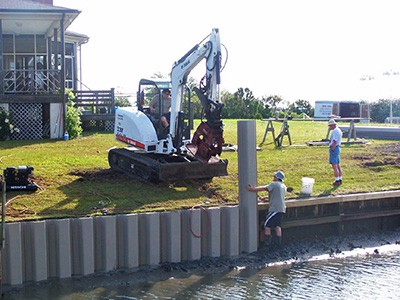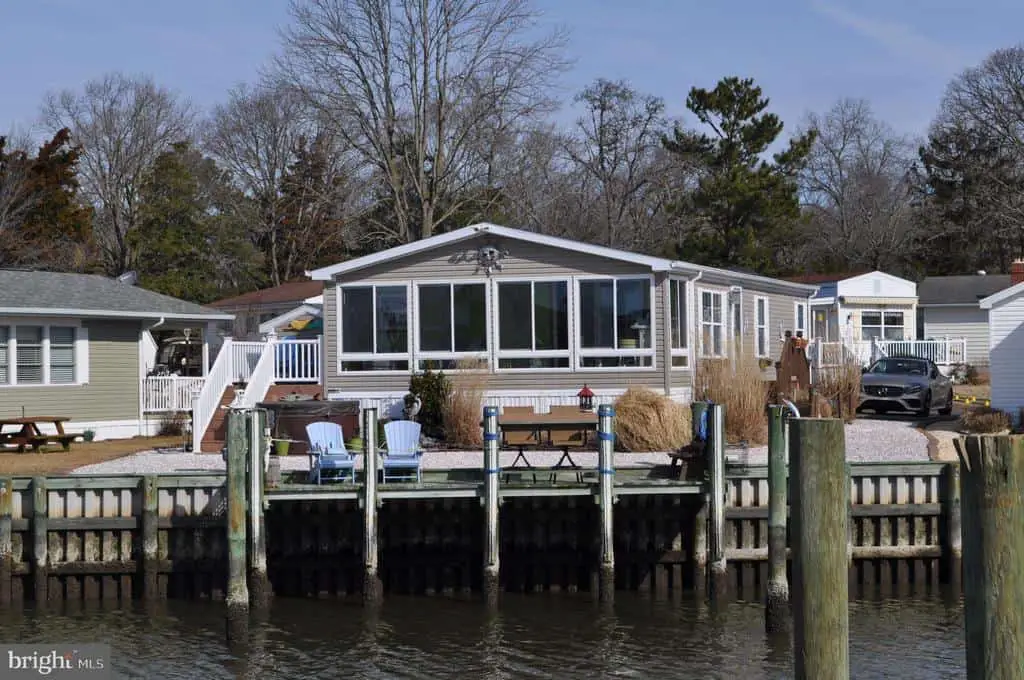There are many waterfront homes that require a Bulkhead. I come from a bay area called Mystic Island in New Jersey where the houses are built on lagoons and require them. After years of use, the wooden Bulkheads break down and a homeowner is left with an expensive choice, replace them with Wood or Vinyl. What’s the difference between a Vinyl and a Wooden Waterfront Bulkhead?
A Vinyl Bulkhead, although more expensive, lasts 2x longer than a Treated Wooden Bulkhead. It resists corrosion, UV, Marine Borers, termites, bacteria & fungus that break down the integrity of the wood. Uses no harmful chemicals & is 100% recyclable.
On the east coast, there are many properties that are low to mid-range modest price houses that use Bulkheads, not just the expensive vacation beach homes. They’re made of old greenwood. Just like all aging infrastructure, it needs to be repaired or replaced. Now, with better choices of materials for replacing a Bulkhead, which is a BIG deal to folks where I come from, It might be the last time they have to do it.
What’s Involved With Getting Your Bulkhead Replaced
Some homeowners in New Jersey have their Bulkheads professionally repaired first, which in my case gave me another 5-10 years of life without having to make the “big decision” as my neighbors called it, of having the Bulkhead totally replaced.
Some people here can’t afford the cost and let them fall apart. Everyone from here has expertise about keeping them going and an opinion about what’s better, Vinyl or Wood.
You can get a good idea of how bad a Bulkhead is by inspecting it at low tide.
- Bulkhead Wormholes caused by a Mollusk called Teredo and barnacles-covered pilings destroy any integrity of the Pilings, Post, and Wall from the inside out.
- The topsoil from the property falls below the grade level of the wall behind and is lost out into the water. It’s a good indication that the wall is completely failing and your property is being lost through the wall little by little as the soil runs through the wall into the water.
- Other signs are the top Bulkhead is crooked and uneven. This usually is an indication that the Tie-Rods that anchor the wall to the Piling and the Deadman in the property are rotted and failing. When this happens the wall will move out and you’ll first notice it happening from the top. Eventually, the tie-rod will break and the whole wall will sort of buckle and move outward.
- The Walls, Post, and Pilings make up the main structure of the Bulkhead, but the Walers, tie-rods, and Deadman Post buried in the earth behind the wall work together to keep everything in place and are critical to supporting the weight of the wall and keep it from moving.
The wooden type Bulkheads can be very attractive and built with pressure-treated wood, pilings, and timber. The level of treatment your wood needs will depend upon the kind of water you are building in.
Typically you will need a .60 PCF retention level in fresh water and 2.5 PCF in brackish or saltwater. Galvanized steel is used on all hardware like tie rods, lag screws, and all-thread all used in construction near water.

For a bulkhead or retaining wall that stands the test of time, polymer coatings are available for your rough-treated lumber components. The special polymer wood coating defends treated wood from attacks by ship worms, barnacles, erosion, and even UV rays.
The new types of coating treatment seal all the nasty things you’ll find around the Pilings and dock. It also prevents chemicals used for pressure treatment from leaching from the wood into the ground or water.
This means that the treatment stays in the lumber forever to protect and preserve it while keeping chemicals out of the environment. Which is a big complaint about the use of treated wood in structures around the waterfront areas.
Most poles and pilings treated .60 PCF or greater are kiln-dried before treatment to ensure maximum penetration of the preservative. Pole and Pilings are basically the same. Pilings are driven into the ground from the pointed side and Poles are driven in on the blunt side or butt end like they are on utility poles. So there are some new developments in construction materials used in Wooden Bulkheads that might make it safer or last a little longer. That’s a good thing.
The industry’s common wood bulkhead design can look like these examples:

From front to back, you will have pilings first. The wale horizontal boards are then connected to the landside of the pilings which have the center match sheets nailed to them.
The filter cloth is there to provide a clean appearance. it keeps the soil behind the bulkhead. To keep the structure from falling over, tie rods support your bulkhead from behind. Deadmen are treated posts (round or square) and are used to “tie-back” the bulkhead and therefore provide support from behind.
They are located on the property behind the wall underground. While not required top caps can give your bulkhead a more finished look and also provide a little more structural integrity.
A wooden bulkhead is very economical and protects property from erosion. While vinyl may last longer because of its synthetic makeup, the wooden bulkhead is less costly and still gets the job done. Built with treated wood, it is protected from parasites in the water.
Replacing a Waterfront Bulkhead is a big messy job that if possible only should do once. A barge is used on the waterside so that the pilings can be driven down from the waterside of the wall.
A backhoe is used to dig out the inside of the wall to ground level to set the Tie Rods and Deadman. Then once in place, the whole thing is backfilled. The project is normally done in a week and is good for years to come.
What Will Last Longer a Vinyl or Wooden Bulkhead
Vinyl has been around for big money, now for 25 or 30 years with Seawalls and Bulkheads being made from Steel, Concrete, and Wood. All of these materials have problems over their lifetime in this hard environment. Steel is expensive and treated with toxic chemicals to keep it from rusting.
Concrete structures will settle and crack then will deteriorate over time. Treated wood is treated with toxic chemicals. It can be damaged by UV exposure and is compromised by fungus, termites, and the most visual the Shipworm or Teredo.
These Marine Borers are a type of Mollusk, that causes holes through Bulkheads and Pilings in Salt and Brackish water. They eat the wood under the surface until it collapses under its own weight.
Vinyl material can be easier installed using no preservatives or toxins than other materials do. It’s UV resistant and impervious to worms, termites, or bacteria. The synthetic material is corrosion-proof (no rust) and has a longer service life. It has been thoroughly tested by the Army Corps of Engineers and has no effect on the environment once it’s in place. It’s made of 100% recycled material. The aesthetic appeal is beautiful and it doesn’t look out of place.
Vinyl sheets used in Bulkheads are built for strength and made from high-grade PVC. They are usually driven or pushed into the ground using a vibratory hammer, backhoe, or jetting system. Because of advances in technology, the spread of production knowledge, and many competitors, vinyl sheet piling has become a commodity item.
That is, they are essentially all the same. The truth is they have a lot of advantages over Treated Wood. The parts and the sheets in some cases are guaranteed for up to 50 years.
Wooden bulkheads have the least expensive up-front costs. You can save some money and spend it on equipment that will dress up your Bulkhead or Dock Ladders like these awesome wide-step aluminum Dock Ladders Wooden Bulkheads are effective and give your waterfront a somewhat natural look. They are treated to stand up to the elements, are effective against the water, and give your waterfront a natural look.
Since the wood is treated with various chemicals to deter wood-boring creatures from munching on the lumber, the average life expectancy of a Pressure-treated bulkhead is 25 years or longer. Take a look at some very cool Dock Lighting recommended for showcasing your Dock & Bulkhead.

Property location, wave exposure, wind exposure, and current are all factors that determine the longevity of a timber Bulkhead. I’ve seen some that surpass that time frame and with the professional repair done to them, look pretty good and continue to do the job.
Sooner or later they outlive themselves and need to be replaced. Wooden Bulkheads have a character to them, a traditional look that can make your property look finished and neat. Some people actually prefer them to Vinyl materials.
The new coating and treatments can add years to its life. So all that being said Wooden Bulkheads are still an option, especially with a lower upfront cost.
New Vinyl material can have a huge advantage in the element that is detrimental to a Wooden Bulkhead and the interlocking sheets that add security and strength. The material is lighter and easily can be transported and needs no maintenance. But there is the Cost.
- Hot, humid H2O conditions
- Fast-growing cumulus clouds
- Two opposing winds spin & create a funnel with an upward air current
- Any water evaporating from that spot gets caught in the funnel.
- Another way in which a Waterspout form is if a tornado is pushed out over the water .………………………………………………………….. Read more
Bulkhead Replacement Cost

Wood bulkheads, also known as treated pilings have the least expensive up-front costs. They are effective and give your waterfront a somewhat natural look. They are treated to stand up to the elements and are effective against the saltwater elements. The wood is treated with various chemicals to deter wood-boring creatures from munching on the lumber.
With the lowest life-cycle cost, vinyl bulkheads are the most cost-effective option in the long term. You can expect the vinyl sheets to last more than 50 years and while you may want to replace some of the wood components during that time, you will not have the additional material and labor expenses of replacing the vinyl sheet pilings.
Prices for Wooden and Vinyl Bulkheads normally include ripping out the previously installed system. Construction companies might pick up the price of Construction permits by around $500.00 from the town’s engineering department and possibly the State. Here in New Jersey, there are a few hands out looking for a cut if you know what I mean.
These prices state to state but can give you a general idea of how it works. Prices are calculated according to linear foot. In New Jersey, Lagoon property plots are normally 50 ft. wide which is standard in most modest Lagoon neighborhoods. The same company will remove the old Bulkhead and replace it with a new one. Either in Vinyl or Wood.
Wooden Bulkhead- $200.00- 300.00 dollars a linear foot.
Vinyl Bulkhead – $400-$500 per/linear ft.
Has it Ever Snowed in Florida?
Yes, but its rare, for snowfall to occur in Florida, the polar jet stream has to move towards the south and into the Gulf of Mexico through Texas, move with a cold front across Southern Florida, and then curve towards the Northeast before combining with cooling air in the frontal clouds ……………………………………………………………….. Read more
How long a Bulkhead lasts really depends on the strength of the water and the harsh conditions that the Bulkhead is constantly exposed to. They make your property safer and easier to add docks and watercraft and to have better access to your property.
They will help to retain soil on your property that would otherwise naturally over time, erode into the water. They can come in different designs and materials like the treated wood, which can add an older traditional flair. The new Bulkhead material is a clean-looking modern composite that is engineered and high-tech that will definitely hold for many years to come.
Most of all, a Bulkhead can give you safety from rising tides and storms that can push water onto your property. The structures and installations of both the Vinyl and the Treated Wooden Bulkheads are not much different but the materials should be the basis of your consideration. They both do the job but for how long!
The replacement and construction of a Vinyl Bulkhead can be a once-in-a-lifetime opportunity to get er done right the first time ………..and the last time!
What Causes Changes in Weather?
Constant changes in weather are the result of changes in temperature, air pressure, and humidity in the atmosphere that result in strong winds and storms that develop and move in continuous motion keeping weather constantly changing along with seasonal changes as the earth revolves around the sun ………………………………………………………….. Read more
JimGalloway Author/Editor

